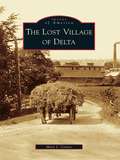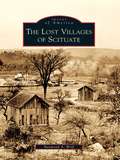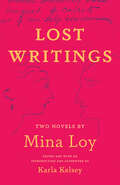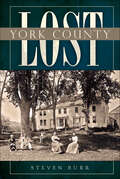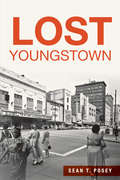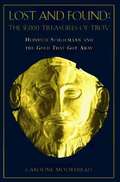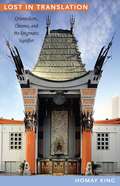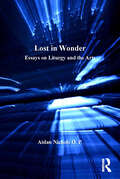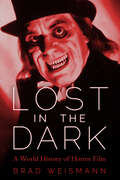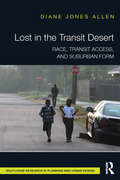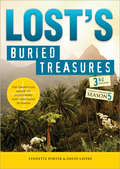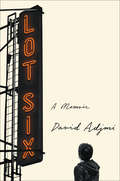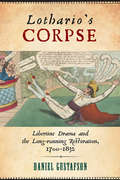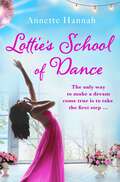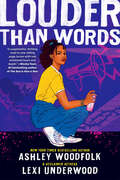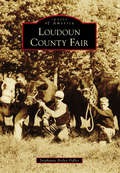- Table View
- List View
Lost Village of Delta, The (Images of America)
by Mary J. CentroHome to a community of hardworking farmers and mill workers, the village of Delta stood along the banks of the Mohawk River until it was evacuated by the state to raise the water in the Erie Canal. Before the flooding of the river, Delta was a small country village with the same postmaster for over 30 years and families farming the same land for generations. In order to raise the water, the state approved the construction of five reservoirs across New York. The town was evacuated soon after, and the land that generations of residents toiled over now sits at the bottom of Lake Delta.
Lost Villages of Scituate, The (Images of America)
by Raymond A. WolfIn 1915, the general assembly appointed the Providence Water Supply Board to condemn 14,800 acres of land in rural Scituate. The hardworking people of the five villages were devastated. By December 1916, notices were delivered to the villagers stating that the homes and land they had owned for generations were to be taken and destroyed. Construction was well under way by 1921, and water was being stored by November 10, 1925. On September 30, 1926, the treatment plant began operation. It now serves more than 60 percent of Rhode Islanders. The $21 million project was the largest ever undertaken in the state at the time. The dam that annihilated the villages is 3,200 feet long and 100 feet high and holds back more than 40 billion gallons of water. Today these quiet villages lie up to 87 feet beneath the cold, dark waters of the Scituate Reservoir.
Lost Writings: Two Novels by Mina Loy
by Mina LoyTwo never-before-published novels by Mina Loy, the celebrated modernist poet, artist, and feminist Mina Loy (1882–1966) is an essential figure of the European and American modernist avant-garde. A groundbreaking writer of poetry, novels, essays, plays, and uncategorizable prose, she was also a fashion and lighting designer and an accomplished visual artist. As gallery agent for figures such as Giorgio de Chirico, Alberto Giacometti, and Salvador Dalí, she was a significant conduit for art that traversed the Atlantic. Loy has been best known for the poetry she published in the little magazines of the late teens and early twenties, most notably the long poem &“Songs to Joannes&” and the autobiographical verse-epic &“Anglo-Mongrels and the Rose.&” Featuring two never-before-published manuscripts of Loy&’s autobiographical prose—The Child and the Parent and Islands in the Air—this remarkable book expands Loy&’s rich oeuvre. Interlinked texts written over twenty years, from the 1930s to the 1950s, these fascinating works narrate the feminist struggle of the creative spirit as it comes into consciousness and encounters indoctrinating social norms. The works are accompanied by an introduction and afterword by Karla Kelsey that frame Loy as a poet, prose writer, businesswoman, and visual artist and discuss the texts, their stylistic innovations, and their unique interconnectedness.
Lost York County (Lost)
by Steven BurrOn October 17, 1947, a fire started near Newfield. It grew quickly and moved east, destroying Goose Rocks Beach, Fortune�s Rock and parts of Cape Porpoise. Thousands of historic buildings perished. The 1947 blaze was unique in the scope of its devastation, but fire has claimed countless York County landmarks over the years. Development projects, neglect and weather have doomed many more. Lost York County presents rare photos of many of these buildings, preserving the visual record of lost town halls, churches, schools, homes and hotels, from Kittery to Biddeford. In this collection of many never-before-seen images, Steven Burr offers a tribute to places and memories seized by time.
Lost Youngstown (Lost)
by Sean T. PoseyThe massive steel mills of Youngstown once fueled the economic boom of the Mahoning Valley. Movie patrons took in the latest flick at the ornate Paramount Theater, and mob bosses dressed to the nines for supper at the Colonial House. In 1977, the Youngstown Sheet and Tube Company announced the closure of its steelworks in a nearby city. The fallout of the ensuing mill shutdowns erased many of the city's beloved landmarks and neighborhoods. Students hurrying across a crowded campus tread on the foundations of the Elms Ballroom, where Duke Ellington once brought down the house. On the lower eastside, only broken buildings and the long-silent stacks of Republic Rubber remain. Urban explorer and historian Sean T. Posey navigates a disappearing cityscape to reveal a lost era of Youngstown.
Lost and Found: Heinrich Schliemann and the Gold That Got Away
by Caroline MooreheadIn this book, journalist and biographer Caroline Moore Head explores Schliemann's extraordinary life and tells how he contrived to smuggle part of the treasure from his dig in Asia Minor to his government in Berlin.
Lost in Translation
by Ella Frances SandersAn artistic collection of more than 50 drawings featuring unique, funny, and poignant foreign words that have no direct translation into English. Did you know that the Japanese language has a word to express the way sunlight filters through the leaves of trees? Or that there's a Finnish word for the distance a reindeer can travel before needing to rest? Lost in Translation brings to life more than fifty words that don't have direct English translations with charming illustrations of their tender, poignant, and humorous definitions. Often these words provide insight into the cultures they come from, such as the Brazilian Portuguese word for running your fingers through a lover's hair, the Italian word for being moved to tears by a story, or the Swedish word for a third cup of coffee. In this clever and beautifully rendered exploration of the subtleties of communication, you'll find new ways to express yourself while getting lost in the artistry of imperfect translation.From the Hardcover edition..From the Hardcover edition.
Lost in Translation: Orientalism, Cinema, and the Enigmatic Signifier
by Homay KingIn a nuanced exploration of how Western cinema has represented East Asia as a space of radical indecipherability, Homay King traces the long-standing association of the Orient with the enigmatic. The fantasy of an inscrutable East, she argues, is not merely a side note to film history, but rather a kernel of otherness that has shaped Hollywood cinema at its core. Through close readings of The Lady from Shanghai, Chinatown, Blade Runner, Lost in Translation, and other films, she develops a theory of the "Shanghai gesture," a trope whereby orientalist curios and dcor become saturated with mystery. These objects and signs come to bear the burden of explanation for riddles that escape the Western protagonist or cannot be otherwise resolved by the plot. Turning to visual texts from outside Hollywood which actively grapple with the association of the East and the unintelligible--such as Michelangelo Antonioni's Chung Kuo: Cina, Wim Wenders's Notebook on Cities and Clothes, and Sophie Calle's Exquisite Pain--King suggests alternatives to the paranoid logic of the Shanghai gesture. She argues for the development of a process of cultural "de-translation" aimed at both untangling the psychic enigmas prompting the initial desire to separate the familiar from the foreign, and heightening attentiveness to the internal alterities underlying Western subjectivity.
Lost in Wonder: Essays on Liturgy and the Arts
by Aidan Nichols P.This book explores the Liturgy as the manifestation by cultic signs of Christian revelation, the 'setting' of the Liturgy in terms of architectural space, iconography and music, and the poetic response which the revelation the Liturgy carries can produce. The conclusion offers a synthetic statement of the unity of religion, cosmology and art. Aidan Nichols makes the case for Christianity's capacity to inspire high culture - both in principle and through well-chosen historical examples which draw on the best in Catholicism, Eastern Orthodoxy and Anglicanism.
Lost in the Dark: A World History of Horror Film
by Brad WeismannTwo horror films were nominated for the Academy Award for Best Picture in 2018, and one of them—The Shape of Water—won. Since 1990, the production of horror films has risen exponentially worldwide, and in 2013, horror films earned an estimated $400 million in ticket sales. Horror has long been the most popular film genre, and more horror movies have been made than any other kind. We need them. We need to be scared, to test ourselves, laugh inappropriately, scream, and flinch. We need to get through them and come out, blinking, still in one piece. Lost in the Dark: A World History of Horror Film is a straightforward history written for the general reader and student that can serve as a comprehensive reference work. The volume provides a general introduction to the genre, serves as a guidebook to its film highlights, and celebrates its practitioners, trends, and stories. Starting with silent-era horror films and ending with 2020’s The Invisible Man, Lost in the Dark looks at decades of horror movies. Author Brad Weismann covers such topics as the roots of horror in literature and art, monster movies, B-movies, the destruction of the American censorship system, international horror, torture porn, zombies, horror comedies, horror in the new millennium, and critical reception of modern horror. A sweeping survey that doesn’t scrimp on details, Lost in the Dark is sure to satisfy both the curious and the completist.
Lost in the Stream: How Algorithms Redefined the Way Movies Are Made and Watched
by Jeff RauseoExplore Cinema History, Stream Your FavoritesThis engaging book by Jeff Rauseo blends film history with a modern guide to streaming, helping you navigate the complex history of movie making and ultimately how to know what to watch in the vast ocean of content. From the golden age of Hollywood to the best new movies to stream, Rauseo breaks down the ever-evolving movie watching experience to help us understand the good, the bad, and the ugly of streaming.Ever feel overwhelmed by endless streaming choices? Jeff Rauseo&’s Lost in the Stream is your ultimate roadmap, combining movie history insights with an in-depth breakdown of how streaming influences the movies that are made and the ones that we are shown. Whether you&’re searching for the best new movies to stream, hidden Amazon Prime movies, or fun movies to watch on Netflix, this book has you covered. Blending nostalgia with today&’s streaming hits, Lost in the Stream dives deep into the iconic history of film that shaped the art while helping you discover new favorites. It&’s the perfect companion for movie buffs and casual viewers alike. Inside, you'll find: A breakdown of the evolution of film watching, from drive-ins to Blockbuster nights and beyond Engaging insights into the impact finances and algorithms have on the movies that are made A guide to discovering the best films for you Never Wonder What to Watch Again.If you liked The New York Times Book of Movies, The Science of Interstellar, or Oscar Wars, you&’ll love Lost in the Stream.
Lost in the Transit Desert: Race, Transit Access, and Suburban Form
by Diane Jones AllenIncreased redevelopment, the dismantling of public housing, and increasing housing costs are forcing a shift in migration of lower income and transit dependent populations to the suburbs. These suburbs are often missing basic transportation, and strategies to address this are lacking. This absence of public transit creates barriers to viable employment and accessibility to cultural networks, and plays a role in increasing social inequality. This book investigates how housing and transport policy have played their role in creating these "Transit Deserts," and what impact race has upon those likely to be affected. Diane Jones Allen uses research from New Orleans, Baltimore, and Chicago to explore the forces at work in these situations, as well as proposing potential solutions. Mapping, interviews, photographs, and narratives all come together to highlight the inequities and challenges in Transit Deserts, where a lack of access can make all journeys, such as to jobs, stores, or relatives, much more difficult. Alternatives to public transit abound, from traditional methods such as biking and carpooling to more culturally specific tactics, and are examined comprehensively. This is valuable reading for students and researchers interested in transport planning, urban planning, city infrastructure, and transport geography.
Lost's Buried Treasures: The Unofficial Guide to Everything Lost Fans Need to Know
by Lynnette Porter David LaveryThe Ultimate Unauthorized Resource to the Stories Behind Lost Lost is a complex and mysterious tale, one that draws on many sources for its themes and ideas-sources you must understand to become an advanced Lost expert. Lost's Buried Treasures is the ultimate unauthorized guide to the ideas that have influenced the show and its writers-and is completely updated through Season Five. Explore: Books and movies important to the show and how they are connected Geographical clues New and old theories Musical references and the meaning behind the incredible soundtrack The best online resources The video and role-playing games and what they've revealed Cast, writer, and director biographies And much more NO TRUE LOST FAN SHOULD EVER WATCH AN EPISODE WITHOUT THIS CRUCIAL GUIDE IN HAND. Explore all the interconnected stories and mysterious references that make the show so fascinating. DISCLAIMER: This book is an independent work of commentary, criticism, and scholarship. Neither this book, nor its author and publisher, are authorized, endorsed or sponsored by, or affiliated in any way with the copyright and trademark owner of Lost and/or the creators of Lost.
Lot Six: A Memoir
by David Adjmi“David Adjmi has written one of the great American memoirs, a heartbreaking, hilarious story of what it means to make things up, including yourself. A wild tale of lack and lies, galling humiliations and majestic reinventions, this touching, coruscating joy of a book is an answer to that perennial question: how should a person be?” — Olivia Laing, author of Crudo and The Lonely CityIn a world where everyone is inventing a self, curating a feed and performing a fantasy of life, what does it mean to be a person? In his grandly entertaining debut memoir, playwright David Adjmi explores how human beings create themselves, and how artists make their lives into art. Brooklyn, 1970s. Born into the ruins of a Syrian Jewish family that once had it all, David is painfully displaced. Trapped in an insular religious community that excludes him and a family coming apart at the seams, he is plunged into suicidal depression. Through adolescence, David tries to suppress his homosexual feelings and fit in, but when pushed to the breaking point, he makes the bold decision to cut off his family, erase his past, and leave everything he knows behind. There's only one problem: who should he be? Bouncing between identities he steals from the pages of fashion magazines, tomes of philosophy, sitcoms and foreign films, and practically everyone he meets—from Rastafarians to French preppies—David begins to piece together an entirely new adult self. But is this the foundation for a life, or just a kind of quicksand? Moving from the glamour and dysfunction of 1970s Brooklyn, to the sybaritic materialism of Reagan’s 1980s to post-9/11 New York, Lot Six offers a quintessentially American tale of an outsider striving to reshape himself in the funhouse mirror of American culture. Adjmi’s memoir is a genre bending Künstlerroman in the spirit of Charles Dickens and Alison Bechdel, a portrait of the artist in the throes of a life and death crisis of identity. Raw and lyrical, and written in gleaming prose that veers effortlessly between hilarity and heartbreak, Lot Six charts Adjmi’s search for belonging, identity, and what it takes to be an artist in America.
Lothario's Corpse: Libertine Drama and the Long-Running Restoration, 1700-1832 (Transits: Literature, Thought & Culture 1650-1850)
by Daniel GustafsonLothario’s Corpse unearths a performance history, on and off the stage, of Restoration libertine drama in Britain’s eighteenth and early nineteenth centuries. While standard theater histories emphasize libertine drama’s gradual disappearance from the nation’s acting repertory following the dispersal of Stuart rule in 1688, Daniel Gustafson traces its persistent appeal for writers and performers wrestling with the powers of the emergent liberal subject and the tensions of that subject with sovereign absolutism. With its radical, absolutist characters and its scenarios of aristocratic license, Restoration libertine drama became a critical force with which to engage in debates about the liberty-loving British subject’s relation to key forms of liberal power and about the troubling allure of lawless sovereign power that lingers at the heart of the liberal imagination. Weaving together readings of a set of literary texts, theater anecdotes, political writings, and performances, Gustafson illustrates how the corpse of the Restoration stage libertine is revived in the period’s debates about liberty, sovereign desire, and the subject’s relation to modern forms of social control. Ultimately, Lothario’s Corpse suggests the “long-running” nature of Restoration theatrical culture, its revived and revised performances vital to what makes post-1688 Britain modern. Published by Bucknell University Press. Distributed worldwide by Rutgers University Press.
Lotteva Wagner Davis: Hand Tattooist & Artist of the American West
by Alan GovenarLotteva Wagner Davis was an American original—a tattooist and western artist in the early to mid-20th century. Following in the footsteps of her parents, Gus and Maud Wagner—tattoo artists and carnival performers—Lotteva was raised in the carnival and started hand tattooing in 1919, when she was just nine years old. She was one of few tattooists to have completely bare skin; her mother forbade her father to tattoo her, relenting only after his death, but Lotteva didn&’t want to be tattooed by anyone but her father. This is the third book in the series on the Wagner family, Last of the Hand Tattoo Artists. It includes tattoo flash by Lotteva and her father, Gus, showing the evolution of hand tattoos from one generation to the next. According to her cousin, Lotteva was &“a person with one foot grounded in the ordinary world and the other in this crazy carnival world.&”
Lottie's School of Dance
by Annette HannahLottie Daniels is dancing up the altar in Canada when she realises her whirlwind wedding is a big mistake. Chad isn't the right person for her at all! And, in that moment, Lottie goes from dancing bride to runaway bride.Much to her brother's relief, Lottie decides to return to Bramblewood in the UK. But life has more surprises in store for her. After rescuing both a donkey and a little old lady called Doris - all with the help of a handsome stranger! - Lottie suddenly becomes a big part of Doris's life. From broken dreams to second chances, Lottie finally has a chance to rebuild her life. When her friends suggest she takes part in a dance audition she refuses point blank but it soon becomes clear that destiny has other plans.You are guaranteed to fall head over heels with this sweet and charming romance.
Lottie's School of Dance
by Annette HannahLottie Daniels is dancing up the altar in Canada when she realises her whirlwind wedding is a big mistake. Chad isn't the right person for her at all! And, in that moment, Lottie goes from dancing bride to runaway bride.Much to her brother's relief, Lottie decides to return to Bramblewood in the UK. But life has more surprises in store for her. After rescuing both a donkey and a little old lady called Doris - all with the help of a handsome stranger! - Lottie suddenly becomes a big part of Doris's life. From broken dreams to second chances, Lottie finally has a chance to rebuild her life. When her friends suggest she takes part in a dance audition she refuses point blank but it soon becomes clear that destiny has other plans.You are guaranteed to fall head over heels with this sweet and charming romance.
Louder Than Words
by Ashley Woodfolk Lexi UnderwoodThis amazing collaboration brings together two inspirational Black artists, NYT bestselling author Ashley Woodfolk and actress Lexi Underwood, for a story about the transformative power of art as protest and its capacity to change the world.When Jordyn Jones transfers to Edgewood High, it's her opportunity to forget everything that happened at her old school. To forget what she and her friends did. To forget who she used to be. That was a different person — this is a fresh start. Now she's someone new, someone better.Except it's the very first day of school, and somehow everyone already seems to know who she is. But Jordyn soon finds a group of friends, and she even starts talking to Izaiah, a soccer star who shares her love of art. Life is good. That's until an anonymous podcast called Tomcat Tea begins revealing humiliating secrets about Edgewood students, ruining their reputations and in some cases their futures. Jordyn and her friends know they have to do something—and this is Jordyn's chance to prove to herself that she's changed.Jordyn's plan to take down the podcast throws her into the spotlight, and as the momentum builds, so do the risks—because Jordyn has a secret of her own, one that could ruin everything . . . and that a mysterious harasser online is threatening to expose.With riveting prose, New York Times bestselling author Ashley Woodfolk and acclaimed actress Lexi Underwood balance an insightful depiction of the power of art as protest with asking some of the biggest questions facing teenagers today—in an era where mistakes can be picked over endlessly online, who is worthy of forgiveness? Can someone ever really change?
Loudoun County Fair
by Stephanie Briley FidlerDating back to 1936, the Loudoun County Fair has been a place for the community to celebrate the agriculture of the area. Established for 4-H members to have a fair of their own, the Loudoun County Fair has provided a place, along with volunteers and the support of the community, for the children to exhibit their animals, home economics projects, and produce. After moving from Purcellville to Middleburg and then to Lincoln, the fair found a permanent home in 1956 on donated land in the Clarke's Gap area of Loudoun County. Since the 1957 fair, a livestock auction has been added, an auditorium has been built, and new barns have been erected. Take a step back, slow down, and enjoy the history and beauty of one of Loudoun's longest-running events, the Loudoun County Fair.
Loudoun County Fire and Rescue Apparatus Heritage (Images of America)
by Mike SandersThe formation of the volunteer fire and rescue departments were a central part of Loudoun County's rich history. In the beginning, residents rallied to provide fire protection and emergency medical care to their neighbors. As more communities wereestablished, fire and rescue departments worked together to provide assistance to each other during an emergency. As Loudoun County experiences incredible growth, volunteers from the communitywork side-by-side with career personnel to ensure that citizens are well protected. The images in this volume capture the history of Loudoun's fire and rescue apparatus, from the earliest trucks to today's modern fire and rescue vehicles. The photographs depict a time when departments struggled to raise funds and provide protection to their communities. This Images of America book shows how far fire and rescue departments have come to ensure the protection of life and property in Loudoun County.
Loudoun County: 250 Years of Towns and Villages
by Mary Fishback Thomas Balch Library CommissionLoudoun County, one of Virginia's most charming areas, is truly a picturesque region, balanced with sweeping pastoral landscapes along the Potomac and many lovely small towns and villages. Over the pastseveral hundred years, this county has enjoyed an ethnic-rich past, meaning that many diverse cultures--the American Indian, European, and African--have called this place home. These different civilizations have left an indelible mark on Loudoun County's character and architectural appearance, from traditional churches and shops to the more ornate and lavish homes scattered across the countryside. Fortunately, many of these buildings still stand, serving as fitting reminders to these different people's struggles and lives. In this volume of over 200 photographs, many never before published, you will experience the Loudoun County of yesteryear--a time when wagons and early automobiles competed for space on the same dusty highways, when homes and schools were made of cobblestone and woodframing, and when life seemed, overall, slower and less complicated. This book takes us on a wonderful journey through the county's major towns, such as Leesburg, Hamilton, Hillsboro, Lovettsville, Middleburg, Purcellville, and Round Hill, and to the smaller villages, such as Waterford, Broad Run Farms, and Taylorstown. From the turn of the twentieth century to more contemporary times, you will see your "home county" as you have never seen it before or as you remembered it as a child.
Loudoun County: A Family Album (Images of America)
by Mary FishbackIn the fast-paced world in which we live, the relationships among families and friends continue to be the bonds that hold our complex communities together. Located in the flourishing region of Northern Virginia, Loudoun County has experienced significant growth in recent years, but it is those essential ties, the determined character of the region's first inhabitants, and the importance ofheritage to the generations that have followed that have truly shaped the area's singular personality. Documented in the contents of leather-bound picturealbums, cardboard boxes, and dusty attic trunks, the most touching stories of the region are found in the collected everyday memories of its people. Loudoun County: A Family Album takes readers on an intimate tour of the county's major towns and small villages through the eyes of the people who lived and worked in these communities. From candid snapshots taken on family vacations and school outings to early photographs of the town's first farmers and entrepreneurs, this volume of over 200 vintage images captures the everyday lives of the citizens who have persevered to make their home the beautiful, diverse, and charming place it has become. Showcasing the work of both Winslow Williams, one of Loudoun's best and most prolific photographers, as well as the efforts of doting parents and grandparents, friendly neighbors, and enthusiastic playmates from throughout the area, this book provides a one-of-a-kind glimpse at the county from a uniquely personal perspective.
Loudoun County: People and Places
by Mary FishbackAlthough geography plays a significant role in a place's identity, it is the people and their stories that make an area special. Loudoun County is one such place, a county known for its charm and uniquepersonality. Over the past 250 years, the county has drawn a truly eclectic population from across the world, and these different immigrant groups have shaped the county's history with their churches, schools, and businesses--all still clearly visible into the twenty-first century. Loudoun County: People and Places highlights the everyday life of itscitizens throughout the county, capturing in word and image the local flavor of Leesburg and the county's many historic towns and villages. Possessing a strong religious presence, Loudoun County is dotted with many old churches, representing a wide network of beliefs and faiths,and this volume takes readers on an extraordinary visual tour showcasing their beautiful exteriors and diverse architectural styles. Throughout the rest of the work, readers will encounter scenes of forgotten one-room schoolhouses, posed snapshots of early faculty members and students, and different views around the county that capture early businesses, local celebrations, and famous homes. This book also features a chapter on the photographs of Winslow Williams, a prolific local studio photographer whose work has preserved many scenes and familiar facesaround the county.
Louis B. Mayer and Irving Thalberg: The Whole Equation (Jewish Lives)
by Kenneth TuranKenneth Turan brings to life the extraordinary partnership of Louis B. Mayer and Irving Thalberg and their role in creating the film industry as we know it &“Sharply observant.&”—Farran Smith Nehme, Wall Street Journal One was a tough junkman&’s son, the other a cosseted mama&’s boy, but they dreamed the same mighty dream: that the right movies could make a profit and change both the culture and individual lives. Sharing a religion and an evangelical zeal for film, Louis B. Mayer (1884–1957) and Irving Thalberg (1899–1936) were unlikely partners in one of the most significant collaborations in movie history. Over the course of their decade-long relationship, as key players at Metro-Goldwyn-Mayer and major players in Hollywood, they joined forces in redefining and mastering the template for the film industry. Mayer, older by more than a dozen years, was the business-minded face of the studio, while Thalberg worked closely with the creative corps, especially writers; together they rarely set a foot wrong. And while Mayer initially viewed Thalberg as the son he never had, the two would go from passionate friends to near enemies before Thalberg&’s shocking death at the age of thirty-seven. In the first joint biography of the two men in fifty years, film critic Kenneth Turan traces their fraught relationship while examining the complicated history of Jewish identity in Hollywood.
